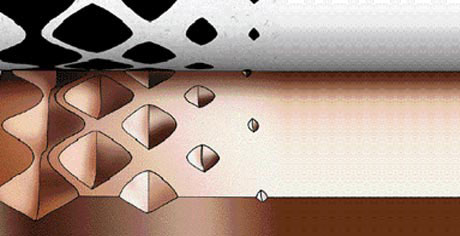Gravure
Gravure is a high quality printing process capable of producing printed images which have a continuous tone effect similar to a photograph.
The gravure process utilizes a metal printing cylinder onto which the image is etched. A gravure cylinder can be created with the analog or digital plating processes.

Applications
There are also many specialty items that are created with rotogravure including gift wrap, wallpaper, imitation wood grain finishes, and vinyl flooring. Gravure is also used for many packaging applications, magazines, and pressure sensitive labels.
A gravure sheet-fed process is used for smaller runs for such items as limited edition prints and other artwork, photographic books, high denomination postage stamps, stock certificates, and some advertising pieces.
Cells
The printing impression produced by the gravure process is accomplished by the transfer of ink from cells of various sizes and depths that are etched into a copper covered steel cylinder.

The cells are different sizes and depths and the cylinder may contain as many as 22,500 cells per square inch. The various sizes and depths of the depressions create the different densities of the image.
A larger or deeper depression, transfers more ink to the printing surface creating a larger and/or darker area. The areas of the cylinder that are not etched become the non-image areas.

Originally, the cells in a gravure cylinder were all equal in area but they were different in depth. Today, the cells that are engraved in the cylinders are different in area and depth or they can be the same depth but different in area. This allows for greater flexibility in producing high quality work for different types of applications. Cells that vary in area but are of equal depth are often used on gravure cylinders for printing packaging applications. The gravure cylinders with cells that vary in area and depth are reserved for the highest quality printing.
Printed images produced with gravure are of the highest quality because the thousands of ink cells appear to merge into a continuous tone image. One drawback with the cells is that the quality of small typefaces, although good, may not be as sharp as type printed with a process such as offset lithography. This is because the type is created with individual cells just like the rest of the image, instead of being printed as a continuous solid shape.
Printing Process
Because of the expense of the cylinders, gravure is largely performed as a rotary web process (rotogravure). It is most often used for very long runs of up to a million and many times the press runs are greater than that. For runs of a million or more, the cylinders are plated with chromium to provide extra durability. If the chromium begins to wear, it is removed from the cylinder and a new coating is applied.
During the printing process, the gravure cylinder revolves in an ink fountain where it is coated with a very fluid ink. A stainless steel blade (doctor blade) clears the ink from the unwanted areas, leaving the ink in the depressions of the cylinder. The substrate passes between the gravure cylinder and an impression cylinder covered in rubber. The substrate passes between the two cylinders and the ink from the cells is deposited onto the substrate.

Besides being very thin and fluid, the ink colors used with process color applications differ in hue than the inks used with other processes. Instead of the usual Cyan, Magenta, Yellow, and Black used with offset lithography, Blue, Red, Yellow, and Black are used. Standards have been established by the Gravure Association of America for the correct ink types and colors that should be used for different types of substrates and printing applications.
Gravure is a direct printing method so there is no need to utilize fountain solution to keep the non-image areas clean. Eliminating this variable allows for better print quality control and jobs can be run at higher speeds. Some applications can be run as high as 3,000 feet per minute. The microscopic depressions on the gravure cylinder create an almost continuous tone image on the printed surface, which is why it is often used for high quality image reproduction.